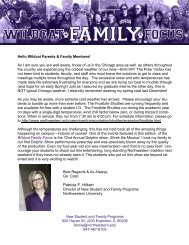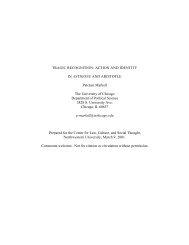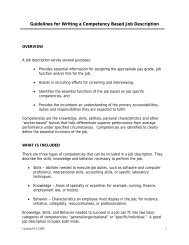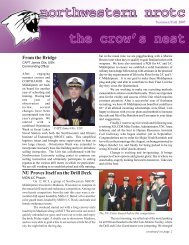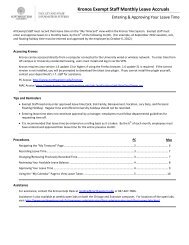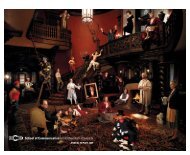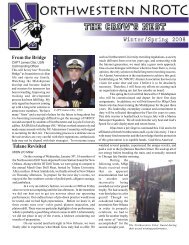Artistry Permits and Custom May Ordain - Northwestern University
Artistry Permits and Custom May Ordain - Northwestern University
Artistry Permits and Custom May Ordain - Northwestern University
You also want an ePaper? Increase the reach of your titles
YUMPU automatically turns print PDFs into web optimized ePapers that Google loves.
28<br />
Kirimba Isl<strong>and</strong>s 108 indigo was grown primarily on Kirimba <strong>and</strong> Kiswi at the mouth of the<br />
Milwani river (Miluâne or Melluane in the Portuguese sources). 109 Dos Santos wrote:<br />
In these l<strong>and</strong>s [Kirimba Isl<strong>and</strong>s] there are many plants of which they make blue dye . . . This plant is<br />
picked by the mouros of the isl<strong>and</strong> . . . And after they have been picked <strong>and</strong> trampled well, then [it is]<br />
laid out in bundles in a wooden trough of water, where it is dissolved into a liquid . . . which they<br />
throw in other troughs, or basins of stone, <strong>and</strong> [then] put in the sun to dry, where they are curdled<br />
<strong>and</strong> dried <strong>and</strong> are gathered . . . And then extracted in fragments dry <strong>and</strong> hard like rock. 110<br />
Following extraction of the indigo solids which could be redissolved, the dye blocks were<br />
used for soaking the cotton thread near Milwani, <strong>and</strong> subsequently the colored thread was<br />
exported to weavers on neighboring isl<strong>and</strong>s. There “rich cloths [were] made for women’s<br />
clothing, Portuguese as well as Mouras [Swahili women], <strong>and</strong> important Mouros [Swahili<br />
men].” Indeed, the reputation of the cloths was so great that Milwani textiles were<br />
sought by non-Swahili aristocrats in the Sofala hinterl<strong>and</strong> <strong>and</strong> on the Zambezi. The<br />
whole Kirimba archipelago came to be referred to simply as “Melluane” in the 1500s<br />
because of the commercial importance <strong>and</strong> primacy of cloth. 111<br />
Dos Santos makes it clear that Milwani cloth was prestigious, owned generally by<br />
“important Mouros” <strong>and</strong> “highly esteemed by the cafres kings of Sofala <strong>and</strong> Rios de<br />
Cuama.” 112 This broad appreciation on the coast <strong>and</strong> in the southern interior for cloths<br />
from the Kirimba archipelago fueled a constant dem<strong>and</strong> for regional textiles even though<br />
(or, for the elite, because) their prices were high. Milwani was also of major significance in<br />
the cross-Mozambique channel trade—a web of commercial networks integrating the<br />
108 It is worth noting that dos Santos says two of the isl<strong>and</strong>s of the archipelago were named Shanga <strong>and</strong> Malindi,<br />
presumably by settlers to the region. 1:275. cf. H. Leitão, ed., Dois Roteiros do séclo XVI, de Manuel Monteiro e<br />
Gaspar Ferreira Reimão, atribuídos a João Baptista Lavanha. Lisbon, 1963.<br />
109 The Kirimba Isl<strong>and</strong>s were also agriculturally productive. Between them, the isl<strong>and</strong>s grew enough rice <strong>and</strong> millet<br />
for export. Dos Santos, 1:288-92. The Milwani area was heavily engaged in trade with the Comoros <strong>and</strong><br />
northwestern Madagascar. “Carta de Sebastião de Sousa para el-Rei, Moçambique, 1521 Setembro 17,” DPMAC.<br />
6:66. On the cartography of the mid-sixteenth century Kirimba archipelago, see da Couto, Decado 10, DPMAC.<br />
8:264-6; G. R<strong>and</strong>les, The Kingdom of Monomotapa on Selected Maps of the Sixteenth Century. London, 1962; <strong>and</strong><br />
Leitão, Dois Roteiros.<br />
110 Dos Santos, Ethiopia Oriental, 1:279.<br />
111 Ibid. In the early sixteenth century, the Portuguese at Mozambique traded heavily in local cloth. After six years<br />
in office as Factor of Mozambique, Diogo Vaz had received 2,871 yards of narrow “cloth of the l<strong>and</strong>.” “Carta de<br />
quitação de Diogo Vaz, fietor de Moçambique, 1513 Julho 13,” DPMAC. 3:472. An indigo cloth used by the<br />
Mijikenda on the northern coast is still called musumbiki, <strong>and</strong> it is possible that Kirimban indigos were exported<br />
to the north until relatively recently. See R. Trillo, “Fashion <strong>and</strong> Fabrics: The Symbolic Use of Cloth in Swahili<br />
Society,” n.p., 1984. 36.<br />
112 Dos Santos, Ethiopia Oriental, 1:279.



